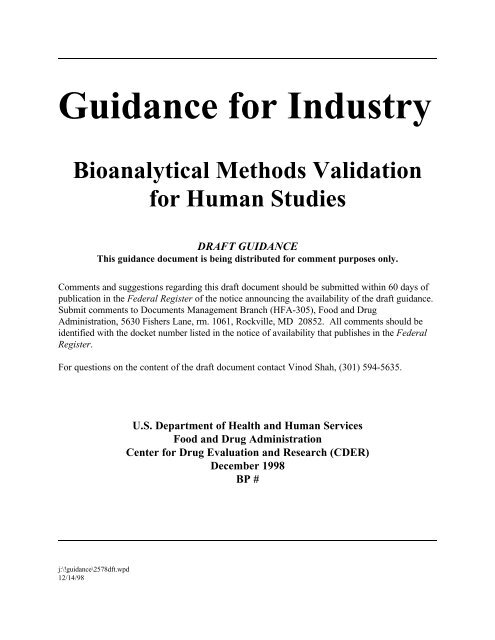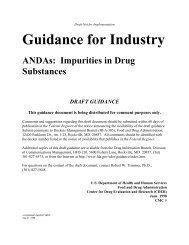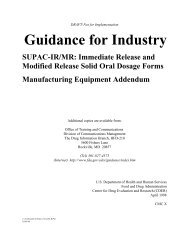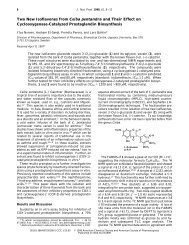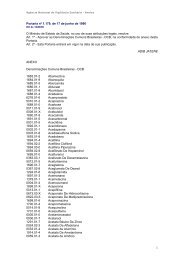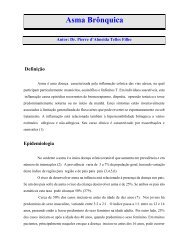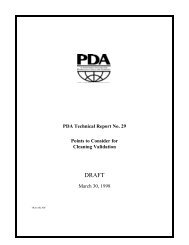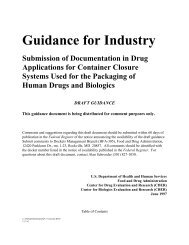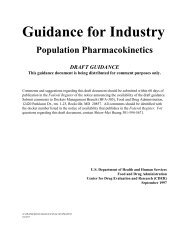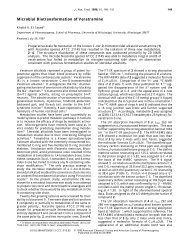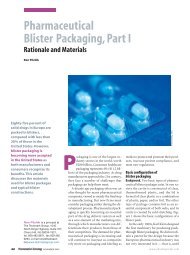Bioanalytical Methods Validation for Human Studies - Pharmanet
Bioanalytical Methods Validation for Human Studies - Pharmanet
Bioanalytical Methods Validation for Human Studies - Pharmanet
Create successful ePaper yourself
Turn your PDF publications into a flip-book with our unique Google optimized e-Paper software.
Guidance <strong>for</strong> Industry<br />
<strong>Bioanalytical</strong> <strong>Methods</strong> <strong>Validation</strong><br />
<strong>for</strong> <strong>Human</strong> <strong>Studies</strong><br />
DRAFT GUIDANCE<br />
This guidance document is being distributed <strong>for</strong> comment purposes only.<br />
Comments and suggestions regarding this draft document should be submitted within 60 days of<br />
publication in the Federal Register of the notice announcing the availability of the draft guidance.<br />
Submit comments to Documents Management Branch (HFA-305), Food and Drug<br />
Administration, 5630 Fishers Lane, rm. 1061, Rockville, MD 20852. All comments should be<br />
identified with the docket number listed in the notice of availability that publishes in the Federal<br />
Register.<br />
For questions on the content of the draft document contact Vinod Shah, (301) 594-5635.<br />
U.S. Department of Health and <strong>Human</strong> Services<br />
Food and Drug Administration<br />
Center <strong>for</strong> Drug Evaluation and Research (CDER)<br />
December 1998<br />
BP #<br />
j:\!guidance\2578dft.wpd<br />
12/14/98
Guidance <strong>for</strong> Industry<br />
<strong>Bioanalytical</strong> <strong>Methods</strong> <strong>Validation</strong><br />
<strong>for</strong> <strong>Human</strong> <strong>Studies</strong><br />
Additional copies are available from:<br />
Drug In<strong>for</strong>mation Branch (HFD-210)<br />
Center <strong>for</strong> Drug Evaluation and Research (CDER)<br />
5600 Fishers Lane, Rockville, MD 20857 (Tel) 301-827-4573<br />
Internet at http://www.fda.gov/cder/guidance/index.htm<br />
U.S. Department of Health and <strong>Human</strong> Services<br />
Food and Drug Administration<br />
Center <strong>for</strong> Drug Evaluation and Research (CDER)<br />
December 1998<br />
BP #<br />
j:\!guidance\2578dft.wpd<br />
12/14/98
Draft — Not <strong>for</strong> Implementation<br />
Table of Contents<br />
I. INTRODUCTION ....................................................1<br />
II. BACKGROUND .....................................................1<br />
III. REFERENCE STANDARD ............................................2<br />
IV. PRE-STUDY VALIDATION ...........................................3<br />
A. Specificity .....................................................3<br />
B. Calibration Curve ..............................................4<br />
C. Precision, Accuracy, and Recovery .................................5<br />
D. Quality Control Samples .........................................6<br />
E. Stability .......................................................7<br />
F. Acceptance Criteria .............................................9<br />
V. IN-STUDY VALIDATION .............................................9<br />
VI. DOCUMENTATION .................................................10<br />
REFERENCES ...........................................................13<br />
j:\!guidance\2578dft.wpd<br />
12/14/98 i
Draft — Not <strong>for</strong> Implementation<br />
GUIDANCE FOR INDUSTRY 1<br />
<strong>Bioanalytical</strong> <strong>Methods</strong> <strong>Validation</strong> <strong>for</strong> <strong>Human</strong> <strong>Studies</strong><br />
I. INTRODUCTION<br />
This guidance provides assistance to sponsors and applicants of investigational new drug<br />
applications (INDs), new drug applications (NDAs), abbreviated new drug applications<br />
(ANDAs), and supplements, in developing validation in<strong>for</strong>mation <strong>for</strong> bioanalytical methods used<br />
in human clinical pharmacology, bioavailability (BA), and bioequivalence (BE) studies. The<br />
guidance does not address analytical methods used <strong>for</strong> nonhuman pharmacology/toxicology<br />
studies, CMC in<strong>for</strong>mation, or in vitro dissolution studies.<br />
The in<strong>for</strong>mation in this guidance is generally applicable to gas chromatography or high-pressure<br />
liquid chromatography analytical methods per<strong>for</strong>med on drugs and metabolites obtained from<br />
biological matrices such as blood, serum, plasma, or urine. This guidance should also apply to<br />
other analytical techniques such as immunological and microbiological methods or other<br />
biological matrices, such as tissue samples including skin samples, although in these cases a higher<br />
degree of variability may be observed.<br />
II.<br />
BACKGROUND<br />
This guidance is based primarily on a conference on Analytical <strong>Methods</strong> <strong>Validation</strong>:<br />
Bioavailability, Bioequivalence and Pharmacokinetic <strong>Studies</strong>, which was held on December 3 - 5,<br />
1990, and sponsored by the American Association of Pharmaceutical Scientists, U.S. Food and<br />
Drug Administration, Federation Internationale Pharmaceutique, the Canadian Health Protection<br />
Branch, and the Association of Official Analytical Chemists (Shah 1992).<br />
Selective and sensitive analytical methods <strong>for</strong> the quantitative determination of drugs and their<br />
metabolites (analytes) are critical <strong>for</strong> successful per<strong>for</strong>mance of clinical pharmacology, BA, and<br />
BE studies. Analytical method validation includes all of the procedures recommended to<br />
1<br />
This guidance has been prepared by the Biopharmaceutics Coordinating Committee and the Clinical<br />
Pharmacology Section of the Medical Policy Coordinating Committee in the Center <strong>for</strong> Drug Evaluation and Research<br />
(CDER) at the Food and Drug Administration. This guidance document represents the Agency’s current thinking on<br />
validation of analytical methods <strong>for</strong> human studies based on drug or metabolite assay in a biological matrix. It does not<br />
create or confer any rights <strong>for</strong> or on any person and does not operate to bind FDA or the public. An alternative approach<br />
may be used if such approach satisfies the requirements of the applicable statute, regulations, or both.<br />
j:\!guidance\2578dft.wpd<br />
12/14/98
Draft — Not <strong>for</strong> Implementation<br />
demonstrate that a particular method <strong>for</strong> the quantitative measurement of an analyte in a given<br />
biological matrix, such as blood, plasma, serum, or urine, is reliable and reproducible. The<br />
parameters essential to this validation include (1) accuracy, (2) precision, (3) sensitivity, (4)<br />
specificity, (5) linearity, and (6) reproducibility. In addition, the stability of the analyte in the<br />
matrix under study storage conditions should be determined. <strong>Validation</strong> involves documenting<br />
through the use of specific laboratory investigations that the per<strong>for</strong>mance characteristics of the<br />
method are suitable and reliable <strong>for</strong> the intended analytical applications (Shah 1992, Taylor 1983).<br />
The acceptability of analytical data corresponds directly to the criteria used to validate the<br />
method.<br />
Published methods of analyte analysis are often modified to suit the requirements of the laboratory<br />
per<strong>for</strong>ming the assay. These modifications should be validated to ensure suitable per<strong>for</strong>mance of<br />
the analytical method. When changes are made to a previously validated method, the analyst<br />
should exercise judgment as to how much additional validation is needed. For minor<br />
modifications, such as a change in the ratio of solvents <strong>for</strong> elution, a change in buffer system, the<br />
number of extractions of the biological matrix, or a small change in column temperature to obtain<br />
better separation, only limited validation may be recommended. For major modifications, such as<br />
change of an instrument, solvent system, detector, or temperature, full validation of the modified<br />
method should be per<strong>for</strong>med.<br />
The analytical laboratory conducting BA and BE studies should closely adhere to FDA’s Good<br />
Laboratory Practices (GLPs) (21 CFR Part 58) and to sound principles of quality assurance<br />
throughout the testing process. In addition, the analytical methods <strong>for</strong> in vivo bioavailability<br />
studies must meet the criteria in 21 CFR 320.29. The analytical laboratory should have a written<br />
set of standard operating procedures (SOPs) to ensure a complete system of quality assurance.<br />
The SOPs should cover all aspects of analysis from the time the sample is collected and reaches<br />
the laboratory until the results of analysis are reported. They also should include record keeping,<br />
security and chain of sample custody (accountability systems that ensure integrity of test articles),<br />
sample preparation, and analytical tools, such as methods, reagents, equipment, instrumentation,<br />
and procedures <strong>for</strong> quality control and verification of results.<br />
The process by which a specific analytical method is validated may be divided into (1) reference<br />
standard preparation, (2) pre-study validation <strong>for</strong> analytical method development and method<br />
establishment, and (3) in-study validation to include study per<strong>for</strong>mance, drug analysis, and<br />
acceptance criteria (Shah 1992, Brooks 1985). These three processes are described in the<br />
following sections of the guidance.<br />
III.<br />
REFERENCE STANDARD<br />
j:\!guidance\2578dft.wpd<br />
12/14/98 2
Draft — Not <strong>for</strong> Implementation<br />
Analysis of drugs and their metabolites in a biological matrix is invariably carried out using<br />
samples spiked with calibration standards and quality control (QC) samples. The quality of the<br />
reference standard used to prepare spiked samples can affect study data. For this reason, an<br />
authenticated analytical reference standard should be used to prepare solutions of known<br />
concentrations. If possible, the reference standard should be identical to the analyte. When this is<br />
not possible, an established chemical <strong>for</strong>m (free base or acid, salt or ester) of known purity can be<br />
used as a surrogate. Three types of reference standards are usually used: (1) certified reference<br />
standards (e.g., USP compendial standards); (2) commercially supplied reference standards<br />
obtained from a reputable commercial source; and/or (3) other materials of documented purity<br />
custom-synthesized by an analytical laboratory or other noncommercial establishment. The<br />
source and lot number, certificates of analyses when available, and/or internally or externally<br />
generated evidence of identity and purity should be furnished <strong>for</strong> each reference standard. A<br />
master standard (a synthetic batch <strong>for</strong> which identity and purity are clearly established and<br />
acceptable) should be maintained <strong>for</strong> each reference standard. All subsequently synthesized<br />
batches are to be compared chromatographically with that master standard. All reference<br />
materials should be checked prior to use to determine if there are significant interfering<br />
chromatographic peaks at the retention time of the analyte and/or the internal standard, using the<br />
analytical procedure to be used in the study.<br />
IV.<br />
PRE-STUDY VALIDATION<br />
Pre-study validation should include analytical method development and documentation.<br />
<strong>Validation</strong> should be per<strong>for</strong>med <strong>for</strong> each biological matrix and <strong>for</strong> each chemical species to be<br />
measured in the biological matrix (Shah 1992, Buick 1990). In addition, the stability of quality<br />
control samples and the analyte in spiked samples should be determined. Typical per<strong>for</strong>mance<br />
parameters that should be assessed during pre-study validation include (1) specificity, (2)<br />
calibration curve and its linearity, (3) precision, accuracy, recovery, (4) quality control samples,<br />
(5) stability of analyte in spiked samples, and (6) acceptance criteria.<br />
A. Specificity<br />
Specificity is the ability of an analytical method to differentiate and quantitate the analyte<br />
in the presence of other constituents in the sample and refers directly to the ability of the<br />
method to produce a response <strong>for</strong> a single analyte (Karnes 1991). For specificity, analyses<br />
of blank samples of the appropriate biological matrix (plasma, urine, or other matrix)<br />
should be obtained from six individuals under controlled conditions, with reference to time<br />
of day, food ingestion, and other factors considered important in the intended study. Each<br />
blank sample should be tested <strong>for</strong> interference using the proposed extraction procedure<br />
and chromatographic or spectroscopic conditions. The results should be compared to<br />
j:\!guidance\2578dft.wpd<br />
12/14/98 3
Draft — Not <strong>for</strong> Implementation<br />
those obtained with an aqueous solution of the analyte at a concentration near the limit of<br />
quantitation (LOQ).<br />
Any blank sample with significant interference at the retention time of the drug,<br />
metabolites, or internal standard should be rejected. If more than 10% of the blank<br />
samples exhibit significant interference at these retention times, additional matrix blank<br />
samples should be tested. If more than 10% of this subsequent group of blank samples<br />
still shows interference, the method should be changed to eliminate the interference.<br />
Potential interfering substances in a biological matrix include endogenous matrix<br />
components, metabolites, decomposition products, and, in the actual study, concomitant<br />
medication. Potential interference from nicotine and common OTC drugs and metabolites,<br />
such as caffeine, aspirin, acetaminophen, and ibuprofen should be routinely tested. If the<br />
method is intended to quantitate more than one analyte, each analyte should be injected<br />
separately to determine its retention time and to ensure that impurities from one analyte do<br />
not have the same retention time as another analyte.<br />
B. Calibration Curve<br />
Calibration is the relationship between instrument response and known concentrations of<br />
the analyte. A calibration (standard) curve should be generated <strong>for</strong> each analyte in the<br />
sample. A sufficient number of standards should be employed to adequately define the<br />
relationship between concentration and response. A calibration curve should be prepared<br />
in the same biological matrix as the samples in the intended study by spiking with known<br />
concentrations of the analyte. Precautions should be taken to avoid precipitation while<br />
spiking the biological matrix. The number of standards used in constructing a calibration<br />
curve will be a function of the anticipated range of analytical values and the nature of the<br />
analyte/response relationship. Concentrations of standards should be chosen on the basis<br />
of the concentration range expected in a particular study. A calibration curve should<br />
consist of a blank sample (matrix sample processed without internal standard), a zero<br />
sample (matrix sample processed with internal standard), and five to eight non-zero<br />
samples covering the expected range, including lower LOQ. Blank and standard zero<br />
samples should not be used in the calibration function, but should only serve to evaluate<br />
interference. Additional factors in developing a calibration curve relate to LOQ and<br />
linearity.<br />
1. Limit of Quantitation (LOQ)<br />
The lowest standard on the calibration curve should be accepted as the limit of<br />
quantitation if the following conditions are met:<br />
j:\!guidance\2578dft.wpd<br />
12/14/98 4
Draft — Not <strong>for</strong> Implementation<br />
C<br />
C<br />
No interference present in blanks at the retention time of the analyte at this<br />
concentration, or typical response at this concentration at least five times<br />
greater than any interference in blanks at the retention time of the analyte<br />
Analyte peak (response) identifiable, discrete, and reproducible with a<br />
precision of 20% and accuracy of 80-120% (Shah 1992).<br />
2. Linearity<br />
The simplest workable regression equation should be used with minimal or no<br />
weighting. Selection of weighting and use of a complex regression equation<br />
should be justified. Four factors should be met in developing a calibration curve:<br />
C #20% deviation of the LOQ from nominal concentration (Shah 1992)<br />
C<br />
C<br />
C<br />
#15% deviation of standards other than LOQ from nominal concentration<br />
(Shah 1992)<br />
At least four out of six non-zero standards meeting the above criteria,<br />
including the LOQ and the calibration standard at the highest concentration<br />
0.95 or greater correlation coefficient (r)<br />
C. Precision, Accuracy, and Recovery<br />
The precision of an analytical method describes the closeness of individual measures of an<br />
analyte when the procedure is applied repeatedly to multiple aliquots of a single<br />
homogeneous volume of biological matrix. Precision should be measured using a<br />
minimum of five determinations per concentration. A minimum of three concentrations in<br />
the range of expected concentrations is recommended. The precision determined at each<br />
concentration level should not exceed 15% coefficient of variation (CV) except <strong>for</strong> the<br />
LOQ where it should not exceed 20% CV. Precision is further subdivided into within-day,<br />
intra-batch precision or reproducibility, which assesses precision during a single analytical<br />
run, and between-day, inter-batch precision or reproducibility, which measures precision<br />
with time and may involve different analysts, equipment, reagents, and laboratories (Shah<br />
1992, USP XXII 1990, Brooks 1985).<br />
The accuracy of an analytical method describes the closeness of test results obtained by<br />
the method to the true value of the analyte. Accuracy is determined by replicate analysis<br />
of samples containing known amounts of the analyte. A minimum of five determinations<br />
j:\!guidance\2578dft.wpd<br />
12/14/98 5
Draft — Not <strong>for</strong> Implementation<br />
per concentration should be conducted <strong>for</strong> a minimum of three concentrations in the range<br />
of expected concentrations. The mean value should be within 15% of the actual value<br />
except at LOQ, where it should not deviate by more than 20%. The deviation from the<br />
true value serves as the measure of accuracy (USP XXII 1990, Brooks 1985).<br />
The recovery of an analyte in an assay is the detector response obtained from an amount<br />
of the analyte added to and recovered from the biological matrix, compared to the<br />
detector response obtained <strong>for</strong> the pure authentic standard (Brooks 1985, Mehta 1989).<br />
Recovery pertains to the extraction efficiency of an analytical method within the limits of<br />
variability. Although recoveries close to 100% are desirable, the extent of recovery of an<br />
analyte and/or the internal standard may be as low as 50 to 60% if the recovery is precise,<br />
accurate, and reproducible. Recovery experiments should be per<strong>for</strong>med by comparing the<br />
analytical results <strong>for</strong> extracted samples at three concentrations (low, medium, and high)<br />
with unextracted standards that represent 100% recovery.<br />
D. Quality Control Samples<br />
Pre-study validation of an analytical method should be carried out using at least three<br />
batches of biological matrix, where each batch is collected from a different source. Each<br />
batch should contain (1) a calibration curve constructed using a blank sample, zero<br />
sample, and five to eight non-zero standards, (2) LOQ quality control (QC) samples, (3)<br />
low QC samples, (4) medium QC samples, (5) high QC samples, (6) a matrix blank<br />
sample, and (7) a reference standard. Quality control samples at concentrations noted<br />
below should be made from a stock solution separate from that used to prepare the<br />
standards.<br />
LOQ QC sample:<br />
Low QC sample:<br />
Same concentration as the lowest non-zero standard<br />
#3 x LOQ<br />
Medium QC sample: Approximately midway between the high and low QC<br />
concentrations<br />
High QC sample:<br />
75 to 90% of highest calibration standard<br />
The accuracy of preparation of calibration and QC samples should be checked with the<br />
first batch. The data from replicate analyses of QC samples and duplicate analyses of<br />
reference standards should be used to obtain the intra-day (within batch) precision, interday<br />
(between batch) precision, accuracy, and recovery.<br />
j:\!guidance\2578dft.wpd<br />
12/14/98 6
Draft — Not <strong>for</strong> Implementation<br />
To obtain within-batch data, the mean, standard deviation, and CV of each QC<br />
concentration in each batch should be calculated. The global (overall) mean, standard<br />
deviation, and CV <strong>for</strong> each QC concentration from the three batches should be calculated<br />
to obtain between-batch data. Precision is indicated by the %CVs. Percent accuracy is<br />
determined by dividing the mean concentration of a QC by its nominal concentration, and<br />
multiplying by 100.<br />
E. Stability<br />
Drug stability in a biological fluid is a function of the storage conditions, the chemical<br />
properties of the drug, the matrix, and the container system. The stability of an analyte in<br />
a particular matrix and container system is relevant only to that matrix and container<br />
system and should not be extrapolated to other matrices and container systems. Stability<br />
procedures should evaluate the stability of the analytes in biological fluids after long-term<br />
(frozen at the intended storage temperature and conditions) and short- term (bench top,<br />
room temperature and conditions) storage, and after going through freeze and thaw cycles<br />
and the analytical process. The procedure should also include an evaluation of analyte<br />
stability in stock solution (Buick 1985, Pachla 1989).<br />
All stability determinations should use a set of standard samples prepared from a freshly<br />
made stock solution of the analyte in the appropriate analyte-free, interference-free<br />
biological matrix. Stock solutions of the analyte <strong>for</strong> stability evaluation should be<br />
prepared in an appropriate solvent at concentrations defined in the method SOP. Further<br />
in<strong>for</strong>mation about validation <strong>for</strong> these factors appears in the following five sections of the<br />
guidance.<br />
1. Freeze and Thaw Stability<br />
Testing <strong>for</strong> freeze and thaw analyte stability should be determined during three<br />
freeze and thaw cycles. At least three aliquots at each of the low and high<br />
0<br />
concentrations should be stored at -20 C, or the intended storage temperature, <strong>for</strong><br />
24 hours and thawed unassisted at room temperature. When completely thawed,<br />
the samples should be transferred back to the original freezer and kept refrozen <strong>for</strong><br />
12 to 24 hours. The cycle of thawing and freezing should be repeated two more<br />
0<br />
times, then analyzed on the third cycle. If an analyte is unstable at -20 C, the<br />
0<br />
stability sample should be frozen at -70 C during the three freeze and thaw cycles<br />
(Shah 1992, Buick 1990).<br />
2. Short-Term Room Temperature Stability<br />
j:\!guidance\2578dft.wpd<br />
12/14/98 7
Draft — Not <strong>for</strong> Implementation<br />
Three aliquots of each of the low and high concentrations should be thawed at<br />
room temperature and kept at this temperature from 4 to 24 hours (based on the<br />
expected duration that samples will be maintained at room temperature in the<br />
intended study) and analyzed (Buick 1990).<br />
3. Long-Term Stability<br />
The storage time in long-term stability evaluation should exceed the time between<br />
the date of first sample collection and the date of last sample analysis. Long-term<br />
stability should be determined by storing at least three aliquots of each of the low<br />
and high concentrations under the same conditions as the study samples. A<br />
suggested storage temperature <strong>for</strong> the majority of drugs and metabolites in a<br />
0 0<br />
biological matrix is -20 C, but lower temperatures (e.g., -70 C) may be<br />
recommended to prevent degradation problems observed at higher temperatures.<br />
The volume of samples should be sufficient <strong>for</strong> analysis on three occasions. The<br />
concentrations of all the stability samples should be compared to the mean of back<br />
calculated values <strong>for</strong> the standards at the appropriate concentrations from the first<br />
day of long-term stability testing (Buick 1990).<br />
4. Stock Solution Stability<br />
The stability of stock solutions of drug and the internal standard should be<br />
evaluated at room temperature <strong>for</strong> at least 6 hours. The stability samples should<br />
then be refrigerated or frozen <strong>for</strong> 7 to 14 days or other relevant period. After<br />
completion of the desired storage time, the stability should be tested by comparing<br />
the instrument response with that of freshly prepared solutions (Buick 1990).<br />
5. Autosampler Stability<br />
The stability of processed samples in the autosampler should be determined at the<br />
autosampler temperature that will be used during analysis, which is usually room<br />
temperature, but may sometimes be a lower temperature (e.g., when a refrigerated<br />
autosampler is used). Stability should be assessed over the anticipated run time <strong>for</strong><br />
the batch size to be used in studies. The stability of both the drug and the internal<br />
standard should be evaluated in validation samples under these conditions by<br />
determining concentrations on the basis of original calibration standards.<br />
Although the traditional approach of comparing analytical results <strong>for</strong> stored<br />
samples with those <strong>for</strong> freshly prepared samples has been referred to in this<br />
guidance, other statistical approaches based on confidence limits are also available<br />
j:\!guidance\2578dft.wpd<br />
12/14/98 8
Draft — Not <strong>for</strong> Implementation<br />
<strong>for</strong> the development of SOPs <strong>for</strong> evaluation of an analyte’s stability in a biological<br />
matrix (Timm 1985). Whatever approach is used, the SOPs should clearly<br />
describe the statistical method and rules employed. Additional validation may<br />
include investigation of samples from dosed subjects.<br />
F. Acceptance Criteria<br />
An analytical method is considered fully validated when it meets the following criteria:<br />
Precision: The between-batch CVs <strong>for</strong> low, medium, and high concentrations should be<br />
#15%, and #20% <strong>for</strong> the LOQ QC, using a minimum of three batches.<br />
Accuracy: The between-batch mean value should be within ±15% of the nominal value at<br />
low, medium, and high QC concentrations and should not deviate by more than ±20% at<br />
the LOQ.<br />
Sensitivity: The lowest standard should be accepted as the limit of quantitation of the<br />
method if the between-batch CV at the LOQ QC is #20%.<br />
Specificity: The responses of interfering peaks at the retention time of the analyte should<br />
be less than 20% of the response of an LOQ standard. Responses of interfering peaks at<br />
the retention time of the internal standard should be #5% of the response of the<br />
concentration of the internal standard to be used in studies.<br />
Stability: Long-term, short-term, freeze and thaw, stock solution, and autosampler<br />
stability data should meet the criteria specified in the SOP.<br />
V. IN-STUDY VALIDATION<br />
Assays of all samples of an analyte in a biological matrix should be completed within the time<br />
period <strong>for</strong> which stability data are available. In general, analysis of biological samples can be done<br />
with a single determination without duplicate or replicate analysis if the assay method has<br />
acceptable variability as defined by validation data. This is true <strong>for</strong> procedures where precision<br />
and accuracy variabilities routinely fall within acceptable tolerance limits. For a difficult<br />
procedure with a labile analyte, where high precision and accuracy specifications may be difficult<br />
to achieve, duplicate or even triplicate analyses may be recommended <strong>for</strong> better estimate of<br />
analyte.<br />
j:\!guidance\2578dft.wpd<br />
12/14/98 9
Draft — Not <strong>for</strong> Implementation<br />
A calibration curve should be generated <strong>for</strong> each analyte to assay samples in each analytical run<br />
and it should be used to calculate the concentration of the analyte in the unknown samples in the<br />
run. The spiked samples may contain more than one analyte. An analytical run could consist of<br />
either all the processed samples to be analyzed as one batch or a batch composed of processed<br />
unknown samples of one or more volunteers in a study, QC samples, and calibration standards.<br />
The calibration (standard) curve should cover the expected unknown sample concentration range<br />
in addition to a calibrator sample at LOQ. Estimation of concentration in unknown samples by<br />
extrapolation of standard curves below LOQ or above the highest standard is not recommended.<br />
Instead, the standard curve should be redefined or samples with higher concentration should be<br />
diluted and assayed (Shah 1992). All study samples from a subject should be analyzed in a single<br />
run.<br />
Once the analytical method has been validated <strong>for</strong> routine use, its accuracy and precision should<br />
be monitored regularly to ensure that the method continues to work satisfactorily. To achieve this<br />
objective, a number of separately prepared QC samples should be analyzed with processed test<br />
samples at intervals based on the total number of samples. The QC samples in duplicate at three<br />
concentrations (one near the LOQ (i.e., #3 x LOQ), one in midrange, and one close to the high<br />
end of the range) should be incorporated in each assay run. The results of the QC samples<br />
provide the basis of accepting or rejecting the run. At least four of the six QC samples should be<br />
within ±20% of their respective nominal value. Two of the six QC samples may be outside the<br />
±20% of their respective nominal value, but not both at the same concentration (Shah 1992,<br />
Brooks 1985, Buick 1990, Mehta 1989, Ayers 1981).<br />
VI.<br />
DOCUMENTATION<br />
The validity of an analytical method should be established and verified by laboratory studies.<br />
Documentation of successful completion of such studies should be provided in the assay<br />
validation report. Protocols that define a set of specific directions that must be followed are<br />
important if the analytical results are useful <strong>for</strong> a given purpose.<br />
General and specific SOPs and good record keeping are essential parts of a validated analytical<br />
method. The analytical protocols and SOPs should be signed and dated by the laboratory director<br />
and updated regularly. The SOP should state situations under which reassay of samples is<br />
permitted. Reassays should be done in triplicate.<br />
The pre-study validation experiments, the data generated from them, and the assay quality control<br />
data should be recorded in a bound laboratory notebook. The entries should be signed by the<br />
chemist and witnessed by the laboratory supervisor. All records should be available <strong>for</strong> data audit<br />
and inspection.<br />
Documentation <strong>for</strong> pre-study validation should include:<br />
j:\!guidance\2578dft.wpd<br />
12/14/98 10
Draft — Not <strong>for</strong> Implementation<br />
! A description of the analytical method<br />
! A description of stability studies and supporting data<br />
! A description of experiments conducted to determine accuracy, precision,<br />
recovery, specificity, linearity, limit of quantitation, and relevant data obtained<br />
from these studies<br />
! Tables of intra- and inter-day precision and accuracy<br />
! Evidence of purity of drug standards, metabolites, and internal standards used in<br />
validation experiments<br />
! Deviations from SOP, if any, and justification <strong>for</strong> deviation<br />
Documentation <strong>for</strong> in-study validation should include:<br />
! Calibration curves used in analyzing samples and intra-day accuracy and precision<br />
data<br />
! In<strong>for</strong>mation on inter-day values of QC samples and data on inter-day accuracy and<br />
precision from calibration curves and QC samples used <strong>for</strong> accepting the analytical<br />
run<br />
! A protocol <strong>for</strong> reassay of samples that describes the reasons <strong>for</strong> reassay and<br />
acceptance criteria <strong>for</strong> reassayed samples<br />
! Reasons <strong>for</strong> missing samples<br />
! Acceptance criteria <strong>for</strong> reported values when all unknown samples are assayed in<br />
duplicate<br />
! Deviations from the protocol or SOP, with reasons and justifications <strong>for</strong> the<br />
deviations<br />
Documentation <strong>for</strong> submission to the Agency should include:<br />
! Pre-study validation data<br />
! Calibration curves, equations, and weighting factors used, if any<br />
! In-study validation data<br />
j:\!guidance\2578dft.wpd<br />
12/14/98 11
Draft — Not <strong>for</strong> Implementation<br />
! Complete serial chromatograms of 20% of subjects, with standards and QC<br />
samples<br />
! All SOPs, raw data, calculations of concentration, and reassay sample sets<br />
j:\!guidance\2578dft.wpd<br />
12/14/98 12
Draft — Not <strong>for</strong> Implementation<br />
REFERENCES<br />
Ayers, G., D. Burnett, A. Griffiths, and A. Richens, “Quality Control of Drug Assay,” Clin<br />
Pharmacokinetics 1981; 6:106-117.<br />
Brooks, M.A. and R.E. Weifeld, “A <strong>Validation</strong> Process <strong>for</strong> Data from the Analysis of Drugs in<br />
Biological Fluids,” Drug Development and Industrial Pharmacy 1985; 11: 1703-1728.<br />
Buick, A.R., M.V. Doig, S.C. Jeal, G.S. Land, and R.D. McDowall, “Method <strong>Validation</strong> in the<br />
<strong>Bioanalytical</strong> Laboratory,” Journal of Pharmaceutical and Biomedical Analysis 1990; 8:629-637.<br />
Karnes, S.T., G. Shiu, and V.P. Shah, “<strong>Validation</strong> of <strong>Bioanalytical</strong> <strong>Methods</strong>,” Pharmaceutical<br />
Research 1991; 8:421-426.<br />
Mehta, A.C., “The <strong>Validation</strong> Criteria <strong>for</strong> Analytical <strong>Methods</strong> used in Pharmacy Practice<br />
Research,” J Clin Pharm Ther 1989; 14:465-473.<br />
Pachla, L.A., D.S. Wright, and D.L. Reynolds, “<strong>Bioanalytical</strong> Considerations <strong>for</strong> Pharmacokinetic<br />
and Biopharmaceutic <strong>Studies</strong>,” J Clin Pharmacol 1986; 26:332-335.<br />
Shah, V.P., K.K.Midha, S.V.Dighe, et al., Analytical <strong>Methods</strong> <strong>Validation</strong>: Bioavailability,<br />
Bioequivalence and Pharmacokinetic <strong>Studies</strong> (Conference report). Pharmaceutical Research<br />
1992; 9:588-592.<br />
Taylor, J.K., “<strong>Validation</strong> of Analytical <strong>Methods</strong>,” Analytical Chemistry 1983; 55:60OA-608A.<br />
Timm, U., M.Wall, and D. Dell, “A New Approach <strong>for</strong> Dealing with the Stability of Drugs in<br />
Biological Fluids,” J Pharm Sci 1985; 74:972-977.<br />
The United States Pharmacopeia XXII: <strong>Validation</strong> of Compendial <strong>Methods</strong>, USP Convention<br />
Inc. 1990; 1710.<br />
j:\!guidance\2578dft.wpd<br />
12/14/98 13


